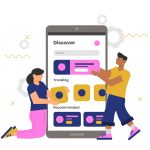The use of machine learning in mobile apps is reshaping how we interact with technology daily. By integrating machine learning (ML), apps can analyze data, predict user preferences, and provide personalized experiences. Let’s explore some real-world applications where machine learning in mobile apps is driving innovation and enhancing user experience.
1. Personalizing Content with ML in Mobile Apps
One common application of ML in mobile apps is content personalization. Streaming apps like Netflix and Spotify use ML algorithms to analyze user behavior, tailoring content recommendations based on users’ past choices and preferences. This keeps users engaged and encourages longer app usage, enhancing satisfaction.
2. Optimizing UX with ML in Mobile Apps
Many companies use ML in mobile apps to improve user experience through predictive text and speech recognition. For example, keyboard apps like Gboard learn from users’ typing patterns to offer accurate predictions, while virtual assistants such as Siri use ML to recognize voice commands and respond more naturally. This technology allows apps to understand and predict user needs more effectively.
3. Enhancing Security Through ML in Mobile Apps
In the realm of security, machine learning in mobile apps is crucial for fraud detection. Banking apps, for instance, apply ML algorithms to monitor transaction patterns, flagging suspicious activity and protecting user accounts. Additionally, facial recognition technologies in apps like Face ID employ ML to verify identities securely, providing seamless access while prioritizing user safety.
4. Improving Health Monitoring and Diagnostics
Healthcare apps are also leveraging machine learning in mobile apps to provide real-time health tracking and diagnostic support. Fitness apps analyze user activity data to offer health insights, while some telemedicine apps use ML algorithms to assess symptoms and provide recommendations. This empowers users to stay on top of their health and make informed decisions.
Conclusion
Machine learning in mobile apps is transforming industries by enabling personalization, improving security, and enhancing the user experience. With continuous advancements, mobile apps will only become smarter and more capable of meeting user demands. For more insights on the impact of technology in various fields, visit Bedots.
Read more: Boosting Engagement with Mobile App Personalization



